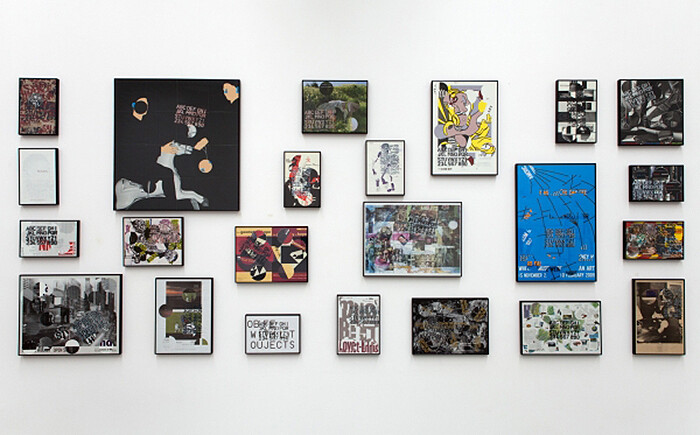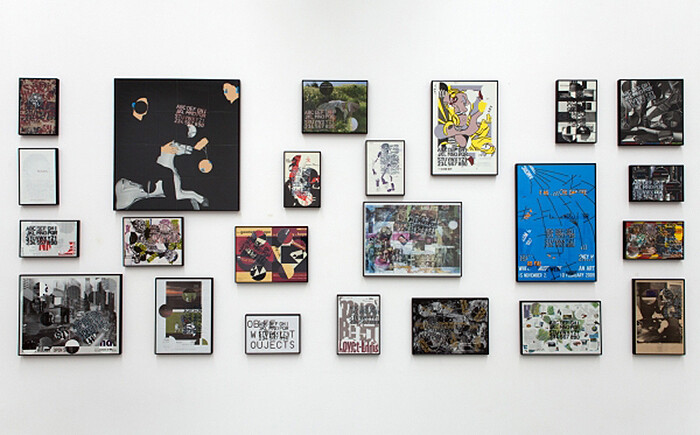With Tina Braegger, Antoine Catala, Ida Ekblad, Nikolas Gambaroff, Nicolas Guagnini, Yngve Holen, Alex Israel, Helen Marten, John Miller, Olivier Mosset, Amy O’Neill, Sean Paul, Carissa Rodriguez, Greg Parma Smith, Alan Uglow, and Hannah Weinberger.
What is the difference between a “standard operating procedure” and a formula, an algorithm, a set of instructions, a program, a system, a recipe or a run book? This exhibition, which takes SOPs as its theme, never makes it quite clear. But its curator, Piper Marshall, contends in her press release that “Today, SOPs are determining the conditions of everyday life,” through such esoteric formulations as search engines, dating sites, self-help books, and targeted advertising.
Artists have applied rules and systems to the manufacture of their work (at least) since Marcel Duchamp dropped pieces of thread to make Three Standard Stoppages (1913). Painters such as Josef Albers, Alfred Jensen, and Ad Reinhardt distilled painting to a programmatic sequence of actions. Conceptualists including Sol LeWitt and Lawrence Weiner took their methods still further, sometimes to the extent that the rules became the work itself.
Marshall’s exhibition acknowledges this legacy, but is not in thrall to it. We never find out how rigorously obedient the included works are to the SOPs that presumably produced them, because the SOPs themselves are never revealed. With some pieces, such as Nicolás Guagnini’s wall of modified posters, State of the Arts (2008), the process is more or less self-evident. Guagnini has cut discs from advertisements for (predominantly New York) exhibitions and reshuffled them, overlaying them with a standard stencil of the alphabet and numbers. A musical soundtrack (available on headphones) includes passages of the children’s song “Now I know my ABCs,” as if surveying the New York art scene was as simple as a pedagogical memory exercise.
Also reflective of the structures of the art world are Carissa Rodriguez’s sculptures Stay Schemin’ and Stay Schemin’ 2 (both 2012) which cobble together gallery reception desks (the shape is unmistakeable) from exhibition advertisements printed on melamine. Rodriguez, like Guagnini, seems sceptical of the debased labor required of ambitious—scheming—cultural workers, whether they are exploited artists or exploited gallery assistants (or, as is often the case, both). Standard operating procedures, the implication goes, can just as easily equate to entrenched systems of exclusion as they can fast tracks to successful outcomes.
Two of the exhibition’s most significant works are also its least conspicuous. Middle of the Day, 03–15–12 and Middle of the Day, 03–15–11 are modest photographs from John Miller’s ongoing series taken between 12 and 2pm. Though shot a year apart, each is a picture of chairs left outside in the street. Miller devised his particular SOP in 1994; that he still considers it worthwhile to gather these unassuming, opportunistic images is testament to the generative potential of such a system. It is his way of reclaiming an ambiguous space in the middle of the working day that might otherwise be given over to lunch, or lunch missed in favor of work. Miller proposes a middle road.
The spectre that haunts the SOP is that of dehumanization and a fatalistic ennui. Some works in this exhibition seem to hide behind vacant stares that could either be construed as critical masks, or as weary stabs at coolness. Greg Parma Smith’s Vibrant Colored Pencil Techniques 3–5 (all 2012) combine zappy marbling techniques with trompe l’oeil deconstructed canvases—a grab bag of currently hip styles so vacuous it hurts. (Therein, perhaps, lies the works’ criticality). Antoine Catala’s rebuses, both titled Fantastic (2012), combine a fan, a letter T, a human ass, and a tick (the insect) to spell their title from framed photographs and sculptural elements. Again, the works’ upbeat mood seems like it should be smuggling irony somewhere, but it’s not clear to what end. The best thing that could be said about Tina Braegger’s inkjet prints of multi-coloured laughing teddy bears is that they’re probably intended to be annoying, and they succeed. There are ten of them.
Marshall writes, tongue in cheek, that SOPs are often “applied when volume is crucial and costs are suppressed.” This is presumably not the priority of any of the artists in this exhibition; nevertheless, once it is acknowledged that there is a standardized system of production in place, one is tempted to ask just what objective it serves. Is it a practical application, or is it ideological? The best works here are those in which the standard operating procedure feels like an excuse, rather than a raison d’être.
Nikolas Gambaroff’s stacks of handmade ceramic plates painted with the dates of their creation, Ida Ekblad’s blue scrap metal gate, Alex Israel’s list of inane but compelling questions for celebrities, and Helen Marten’s remarkable animated film Dust and Piranhas (2011) all deploy their individual SOPs as grease within the engine, rather than the engine itself. Best of all is Yngve Holen’s hanging sculpture Parasagittal Brain (2012)—a hosepipe bisected by high-powered water jets, with a single contact lens, still in its capsule of saline, glued on top of each. Like the best art, Holen’s work ascribes to a logical system that, while it may make perfect sense to its maker, remains tantalisingly out of reach for everyone else.







